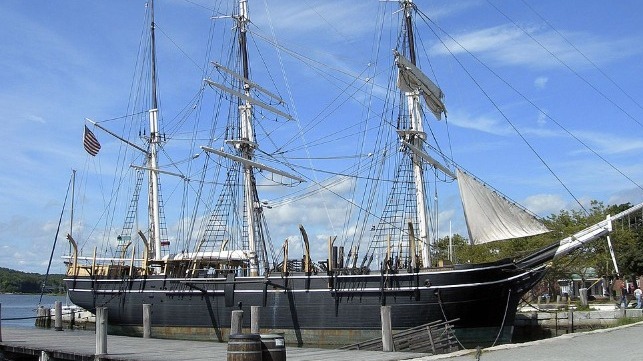The Charles W. Morgan and Whaling Captains of Color

In 2014, the re-launch of the Charles W. Morgan, America’s last whaleship, provided quite a bit of excitement on Martha’s Vineyard Island. The island had flourished thanks to whaling, and my town of Oak Bluffs had been built with whaling proceeds in the late 1800’s. After 37 whaling voyages, the Morgan had undergone a historical renovation from 1973 to 2014.
Although she never sailed to or from the island, the connections between the Morgan and Martha’s Vineyard are long and deep. Launched on July 21, 1841, seventeen of her original crew of thirty – and her captain, Thomas Norton - were Vineyarders, four of whom went on to become captains themselves. Over her years of service, seven of the Morgan’s 21 captains were from here. Second only to the USS Constitution, the Morgan is one of the oldest ships in the country, and her well-publicized visits to New Bedford, where she was built, Provincetown and Stellwagen Bank, where whales were once hunted, and Martha’s Vineyard were widely anticipated. Tshis was the first time anyone alive had ever seen an American whaleship under sail.
At 105 feet long with a beam of 27 feet, the Morgan would seem diminutive today, but rounding West Chop in Vineyard Sound on her way to a berth in Vineyard Haven’s harbor on June 23, 2014 she was the biggest thing on the water. I was the Town of Oak Bluffs columnist for the Vineyard Gazette, which also owned Martha’s Vineyard Magazine which devoted the May 2014 issue to the last whaleship. I was tasked to write a piece on a Vineyard African American whaleship captain, William A. Martin.
A black whaling captain? How could a black man have become any kind of captain in the 1800’s? Acquiring and reading 100 or so whaling books, a couple of hundred monographs, masters and other thesis’ and interweb articles, this research resulted in my book, "Whaling Captains of Color – America’s First Meritocracy," which the Naval Institute Press is publishing on June 15.
It turns out that there have been at least 52 of these men, whose stories are included—and there may likely have been a dozen or so more. One of the better known was Paul Cuffe, the first, who led the way in the late 1700s.
Whaling was second only to mining in danger and second to none as an unforgiving occupation. It was highlighted by boredom, cannibalism, inadequate clothing, desertion, disease, poor food, odors from hell, bad and inexperienced management, barbaric medical care, mutiny, parsimonious owners, poor pay, cramped quarters, vermin infestation, frightening weather and at times whales that fought back. Indeed, it was so awful that most people only went once. This created opportunity for men who were legally and socially marginalized who, after many trips, were able to gain experience and develop the skills needed to be successful.
Over more than 200 years of American whaling some 175,000 men participated, 30% - 40% of whom were men of color. These included free Negroes, American black men originally from Africa, former slaves, West Indians, Native American Indians, Cape Verdeans, Portuguese, Hawaiians, Maori, and South Sea Islanders. They were identified by Seaman’s Protection Certificates (authorized by Congress in 1796) as people with skin that was black, brown, yellow or any range of tan described as colored, copper, mixed, mulatto or mustee - the peculiar term used for the product of relationships between black and Native American partners like Paul Cuffe.
Each of 15,913 whaling voyages was a separate business enterprise with a financial model similar to today’s private equity fund. There were over 2,700 ships that left port to find the whale, kill it, cut it up, melt it down to oil, fill the hull, and return home on trips that averaged 3-4 years. For these long periods of time, on these relatively small whale ships, men had to get along – regardless of their race. Discipline aboard whalers for 3-4 years was paramount and captains were virtually omnipotent. For example, flogging wasn’t outlawed until 1850, and captains of color could also flog white men aboard ship – who for most of those years they couldn’t look in the eye on land.
Of 2,500 total whaling captains, about 950 were replaced aboard ship due to sickness, death or some terrible accident. Whether decided by an American consul or shipboard acclaim, 1,200 miles from shore – no one cared who could get a ship home with its cargo – 52 of them were men of color, about half of whom attained the rank as a replacement captain.
For the majority of whaling’s history, slavery was the law of the land - except in Massachusetts, where it was outlawed in 1783. Over the industry's life from 1715 to 1928, 56 of all 73 whaling ports were located in Massachusetts, two of which were on Martha’s Vineyard (Edgartown and Vineyard Haven/Holmes Hole). This was where I was enchanted to witness the arrival of the last whale ship, the Charles W. Morgan. On her last trip from September 9, 1920 to May 28, 1921, she was led by Captain John T. Gonsalves - who, with his entire crew of 24, were men of color from Cape Verde.
Skip Finley is a retired broadcaster who has written for, been featured or quoted in most media industry trade publications. Skip built his career in radio, becoming a well-known executive and station owner. He served as Vice Chairman of the National Association of Broadcasters and Chairman of the Radio Advertising Bureau. He served on virtually all broadcasting industry boards of directors, and on their executive committees. For more information, visit skipfinley.com.
The opinions expressed herein are the author's and not necessarily those of The Maritime Executive.
